 This thesis describes the development and activity of various organic and nanometallic catalysts, supported in different ways on the inner walls of glass microreactors. ‘Their catalytic activity is proven in a variety of acid-catalyzed reactions, C-C cross-couplings and reductions,’ says Roberto Ricciardi.
This thesis describes the development and activity of various organic and nanometallic catalysts, supported in different ways on the inner walls of glass microreactors. ‘Their catalytic activity is proven in a variety of acid-catalyzed reactions, C-C cross-couplings and reductions,’ says Roberto Ricciardi.
In lab-on-a-chip devices and other continuous-flow microreactors, organic reactions possess numerous thinkable advantages as compared to batch scale synthesis. This is due to the little amounts of chemicals needed, the relative large reaction surfaces attainable, and controllable high-throughput strategic surveys possible.
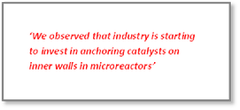
The reactions can be conducted even more efficiently with supported catalysts. ‘In my PhD work, I concentrated on anchoring different kinds of acidic and nanoparticle catalysts to the walls of the microreactors by modifying the surface,’ says Roberto Ricciardi. ‘In particular, supported catalysts enable heterogeneous catalysis to be conducted in an efficient way.’
Sulfonic acid groups
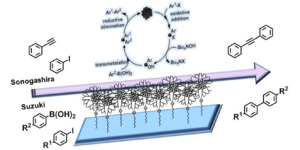
In the first part of the thesis Roberto introduces sulfonic acid groups within microreactors, a special feature being sulfonic acid-bearing polymer brushes, grown on the inner walls. Thereby the activity and stability of the active groups was improved. ‘For measuring the catalytic performances we compared the efficiency with model reactions,’ Roberto explains. ‘We observe that industry is starting to invest in this kind of technologies. This is a good thing as it will bring future applications more within reach. The anchoring of catalysts and modifying the surfaces, may also become attractive in membrane applications for example, to mimic bodily events more lifelike.’
Submitted
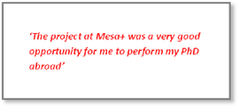
A very positive surprise Roberto experienced during the second half of his thesis work. This part deals with the use of dendrimer-encapsulated metallic nanoparticles, covalently attached to the inner surface of a microreactor. Dendrimers-encapsulated palladium nanoparticles imparted high catalytic activity in a very stable way. The dendrimer template stabilized the palladium nanoparticles over seven days of consecutive use with minimal leaching.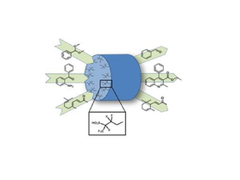
Roberto: ‘We submitted our finding to the Journal ChemCatChem and it was accepted within two days. Also it was chosen as a cover story in the very next edition. Even my supervisor, Professor Jurriaan Huskens, never experienced this kind of quick success before.’
New skills
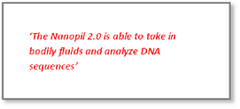
After completing his master as a pharmaceutical chemist, Roberto grasped the opportunity to go and work within the Mesa+ institution. ‘At that time I had a strong desire to perform my PhD abroad, in a different kind of research field, developing new skills. The position at Mesa+ was a very good opportunity to do so, and it certainly did meet my expectations. I was especially impressed by the facilities present here, together with the technical support I got.’
Nanopil 2.0
At this very moment Roberto is working as a post-doc in the Nanopill 2.0 project, led by Mesa+ professor Albert van den Berg. The concept here contains a small chip which is built in a pill, to be swallowed by a patient.
Roberto: ‘The pill is able to take in bodily fluids and analyze DNA sequences. Three different groups within Mesa+ work on this project, each with their own devices. Functionalizing the surfaces and attaching catalysts may favor protein interactions. This is an important research topic all the way through.
‘After my post-doc I prefer working within industry, as striving for an academic career is quite competitive these days. I would like to work on this kind of devices in pharmaceutics, hoping to combine my skills as a ‘classical chemist’ and a fluid dynamics engineer, at micro and nano scale levels.’
